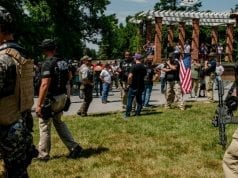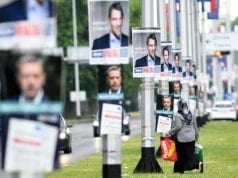
 Driving vehicles into protesters demanding justice for George Floyd earned the backing of the mayor, but of few others * George Floyd killing – latest US updates * See all our George Floyd coverageIt doesn’t take long to blow up a reputation. In the case of the New York police department, an institution with an already troubled history, the clip lasted all of 27 seconds.It showed an NYPD vehicle in Brooklyn lined up against a metal barricade behind which protesters were chanting during Saturday’s demonstrations over the police killing of George Floyd. Projectiles were thrown on to the roof of the car, then suddenly a second police SUV drew up alongside and instead of stopping continued to plough straight into the crowd.Seconds later the first vehicle lurched forward, knocking the barrier over and with it propelling several protesters to the ground amid a harrowing chorus of shrieking.A 27-second video, now viewed more than 30m times, had quickly shredded years of effort to repair the deeply tarnished image of the NYPD. New York’s “finest” were firmly cast in a role normally reserved for the security corps of petty dictators.The shocking video was compounded hours later when the mayor of New York, Bill de Blasio, spoke about the incident. A politician who won election in 2013 largely on a promise to reform the NYPD and scrap its racially discriminatory stop-and-frisk policy, astounded even his closest supporters when he defended the police.De Blasio said: “I do believe the NYPD has acted appropriately.”Social media lit up. Was it appropriate to drive those two SUVs into the crowd? Was it appropriate for an NYPD officer forcibly to remove the coronavirus mask of a black protester whose arms were raised in the air, then pepper-spray his face?Was it appropriate for another officer to tell a protester to get off the street, then physically shove her several feet towards the curb where she landed on her head? Or that the police officers involved in the pepper spray incident had covered their badge numbers, presumably to avoid having to answer for their actions. Or to beat a nurse walking home from a shift at a hospital?The clashes between New York’s police and its protesters have reverberated around the city. The largest police force in the US, with its $5.6bn annual budget and 36,000 uniformed officers under the leadership of one of the most progressive mayors in the country, has responded to demonstrations about police brutality with more police brutality.The Black, Latino and Asian Caucus of the city council, which makes up more than half of the legislative body, was swift and devastating in its criticism. In a statement, it said that the NYPD had acted “with aggression towards New Yorkers who vigorously and vociferously but nonetheless peacefully advocated for justice”.Adrienne Adams, co-chair of the caucus, told the Guardian the NYPD had tried to suppress legitimate anger felt by African American and other minority communities following years of police abuse. “We cannot allow people who have kept people of color down for decades to say now that we don’t have the right to display our outrage,” she said.Though that sentiment applies nationwide, Adams believes New York stands out as having a “horrible history of police brutality”. It was the NYPD that set the tone, she said, when Daniel Pantaleo, the officer implicated in the 2014 death by chokehold of Eric Garner in Staten Island, avoided prosecution.“When nothing happened to the police officers who were responsible for the death of Eric Garner, New York set the blueprint for what happened to George Floyd,” she said. “There’s no penalty, no consequence, so it’s OK.”Adams’s framing of the Garner killing could equally be applied to a long string of notorious episodes of police misconduct that preceded it. In 1997, Haitian immigrant Abner Louima was handcuffed by an NYPD officer and sexually assaulted with a broken broomstick.Two years later, Amadou Diallo was shot near his home in a hail of 41 bullets after officers mistook his wallet for a gun. In an echo of that event, an unarmed Sean Bell was shot 50 times in Queens on the morning of his wedding in 2006 – it took six years for the NYPD detective who opened the fusillade to be chucked off the force while nobody has ever been convicted of any crime.In the policing of protest, the NYPD also has a contentious track record. In 2004 it rounded up more than 1,800 peaceful protesters rallying outside the Republican National Convention during the re-election bid of George W Bush and herded them into overcrowded pens on Pier 57 in Manhattan. In 2011 it was similarly criticized for heavy-handed tactics during the Occupy Wall Street demonstrations.Cutting across all this, the force has consistently targeted its efforts on neighborhoods of the city with majority black or Latino populations, straying at times into overt racial profiling. Though stop and frisk has been reined back in recent years, the NYPD continues to heavily and disproportionately police those communities despite a historically low homicide rate.Despite this long legacy of overreach, the force continues to be systemically resistant to public oversight. Under Section 50-A of New York state law, the disciplinary files of police officers are largely held in secret, making the task of holding them accountable almost impossible.Jennvine Wong, a staff attorney at the Cop Accountability Project (CAP) within the Legal Aid Society, told the Guardian that there were currently more than 200 police officers still being employed by the NYPD on full pay who should have been considered for termination following reports of misconduct.Data collected by CAP shows that where cases of misconduct arise they often involve escalation of low-level encounters into aggressive confrontations – something officers are supposed to be trained not to do. The project is currently litigating the case of Tomas Medina who was put in a chokehold and Tasered in 2018 after police were called to a complaint about loud music being played.Eric Garner’s fatal arrest was triggered by him allegedly selling single cigarettes.Although the use of chokeholds has been banned in New York, the project has found that between 2015 and 2018 the city settled 30 lawsuits involving NYPD use of the potentially lethal maneuver.Wong believes such endemic deployment of excessive force has spilled over into the NYPD’s handling of the George Floyd protests. She was present at a peaceful protest in Brooklyn that suddenly turned volatile not because of the behavior of protesters but by a sudden change of tack on the part of the police.“In a split second, the NYPD snapped and engaged in over-aggressive enforcement. They escalated it from 0 to 10 out of nowhere, arresting people and wielding their batons.”If there has been unrestrained use of batons in the city, it would be with the full approval of Ed Mullins, the provocative president of one of the main police unions, the Sergeants Benevolent Association (SBA). He wrote to members urging “each and every one of you to report for duty with your helmet and baton and do not hesitate to utilize that equipment in securing your personal safety”.The sister Police Benevolent Association of New York City has also spoken to its members in inflammatory terms about them being “under attack by violent, organized terrorists while New York City council and other politicians sit at home demanding we ‘de-escalate’”.There is no denying that the NYPD faces difficult challenges in the policing of mass protests, especially late at night when violent outbreaks have erupted as they did on Monday in Manhattan and the Bronx. Fires were started in the street and stores looted.For Eugene O’Donnell, a former NYPD officer and prosecutor in Brooklyn and Queens who is now a professor of police studies at John Jay College of Criminal Justice, Monday night’s spectacle of looting along Fifth Avenue amounted to a collapse of policing in the city.“This weekend, the job of police officer in New York became officially impossible when the police abolitionists won. They have created a model of zero tolerance towards force being used and any injuries being inflicted, and that’s absurd.”O’Donnell said the same pattern is repeating itself across America. “In city after city, the police were abolished this weekend. They stood back and watched as damage was inflicted that was irreversible.”
Driving vehicles into protesters demanding justice for George Floyd earned the backing of the mayor, but of few others * George Floyd killing – latest US updates * See all our George Floyd coverageIt doesn’t take long to blow up a reputation. In the case of the New York police department, an institution with an already troubled history, the clip lasted all of 27 seconds.It showed an NYPD vehicle in Brooklyn lined up against a metal barricade behind which protesters were chanting during Saturday’s demonstrations over the police killing of George Floyd. Projectiles were thrown on to the roof of the car, then suddenly a second police SUV drew up alongside and instead of stopping continued to plough straight into the crowd.Seconds later the first vehicle lurched forward, knocking the barrier over and with it propelling several protesters to the ground amid a harrowing chorus of shrieking.A 27-second video, now viewed more than 30m times, had quickly shredded years of effort to repair the deeply tarnished image of the NYPD. New York’s “finest” were firmly cast in a role normally reserved for the security corps of petty dictators.The shocking video was compounded hours later when the mayor of New York, Bill de Blasio, spoke about the incident. A politician who won election in 2013 largely on a promise to reform the NYPD and scrap its racially discriminatory stop-and-frisk policy, astounded even his closest supporters when he defended the police.De Blasio said: “I do believe the NYPD has acted appropriately.”Social media lit up. Was it appropriate to drive those two SUVs into the crowd? Was it appropriate for an NYPD officer forcibly to remove the coronavirus mask of a black protester whose arms were raised in the air, then pepper-spray his face?Was it appropriate for another officer to tell a protester to get off the street, then physically shove her several feet towards the curb where she landed on her head? Or that the police officers involved in the pepper spray incident had covered their badge numbers, presumably to avoid having to answer for their actions. Or to beat a nurse walking home from a shift at a hospital?The clashes between New York’s police and its protesters have reverberated around the city. The largest police force in the US, with its $5.6bn annual budget and 36,000 uniformed officers under the leadership of one of the most progressive mayors in the country, has responded to demonstrations about police brutality with more police brutality.The Black, Latino and Asian Caucus of the city council, which makes up more than half of the legislative body, was swift and devastating in its criticism. In a statement, it said that the NYPD had acted “with aggression towards New Yorkers who vigorously and vociferously but nonetheless peacefully advocated for justice”.Adrienne Adams, co-chair of the caucus, told the Guardian the NYPD had tried to suppress legitimate anger felt by African American and other minority communities following years of police abuse. “We cannot allow people who have kept people of color down for decades to say now that we don’t have the right to display our outrage,” she said.Though that sentiment applies nationwide, Adams believes New York stands out as having a “horrible history of police brutality”. It was the NYPD that set the tone, she said, when Daniel Pantaleo, the officer implicated in the 2014 death by chokehold of Eric Garner in Staten Island, avoided prosecution.“When nothing happened to the police officers who were responsible for the death of Eric Garner, New York set the blueprint for what happened to George Floyd,” she said. “There’s no penalty, no consequence, so it’s OK.”Adams’s framing of the Garner killing could equally be applied to a long string of notorious episodes of police misconduct that preceded it. In 1997, Haitian immigrant Abner Louima was handcuffed by an NYPD officer and sexually assaulted with a broken broomstick.Two years later, Amadou Diallo was shot near his home in a hail of 41 bullets after officers mistook his wallet for a gun. In an echo of that event, an unarmed Sean Bell was shot 50 times in Queens on the morning of his wedding in 2006 – it took six years for the NYPD detective who opened the fusillade to be chucked off the force while nobody has ever been convicted of any crime.In the policing of protest, the NYPD also has a contentious track record. In 2004 it rounded up more than 1,800 peaceful protesters rallying outside the Republican National Convention during the re-election bid of George W Bush and herded them into overcrowded pens on Pier 57 in Manhattan. In 2011 it was similarly criticized for heavy-handed tactics during the Occupy Wall Street demonstrations.Cutting across all this, the force has consistently targeted its efforts on neighborhoods of the city with majority black or Latino populations, straying at times into overt racial profiling. Though stop and frisk has been reined back in recent years, the NYPD continues to heavily and disproportionately police those communities despite a historically low homicide rate.Despite this long legacy of overreach, the force continues to be systemically resistant to public oversight. Under Section 50-A of New York state law, the disciplinary files of police officers are largely held in secret, making the task of holding them accountable almost impossible.Jennvine Wong, a staff attorney at the Cop Accountability Project (CAP) within the Legal Aid Society, told the Guardian that there were currently more than 200 police officers still being employed by the NYPD on full pay who should have been considered for termination following reports of misconduct.Data collected by CAP shows that where cases of misconduct arise they often involve escalation of low-level encounters into aggressive confrontations – something officers are supposed to be trained not to do. The project is currently litigating the case of Tomas Medina who was put in a chokehold and Tasered in 2018 after police were called to a complaint about loud music being played.Eric Garner’s fatal arrest was triggered by him allegedly selling single cigarettes.Although the use of chokeholds has been banned in New York, the project has found that between 2015 and 2018 the city settled 30 lawsuits involving NYPD use of the potentially lethal maneuver.Wong believes such endemic deployment of excessive force has spilled over into the NYPD’s handling of the George Floyd protests. She was present at a peaceful protest in Brooklyn that suddenly turned volatile not because of the behavior of protesters but by a sudden change of tack on the part of the police.“In a split second, the NYPD snapped and engaged in over-aggressive enforcement. They escalated it from 0 to 10 out of nowhere, arresting people and wielding their batons.”If there has been unrestrained use of batons in the city, it would be with the full approval of Ed Mullins, the provocative president of one of the main police unions, the Sergeants Benevolent Association (SBA). He wrote to members urging “each and every one of you to report for duty with your helmet and baton and do not hesitate to utilize that equipment in securing your personal safety”.The sister Police Benevolent Association of New York City has also spoken to its members in inflammatory terms about them being “under attack by violent, organized terrorists while New York City council and other politicians sit at home demanding we ‘de-escalate’”.There is no denying that the NYPD faces difficult challenges in the policing of mass protests, especially late at night when violent outbreaks have erupted as they did on Monday in Manhattan and the Bronx. Fires were started in the street and stores looted.For Eugene O’Donnell, a former NYPD officer and prosecutor in Brooklyn and Queens who is now a professor of police studies at John Jay College of Criminal Justice, Monday night’s spectacle of looting along Fifth Avenue amounted to a collapse of policing in the city.“This weekend, the job of police officer in New York became officially impossible when the police abolitionists won. They have created a model of zero tolerance towards force being used and any injuries being inflicted, and that’s absurd.”O’Donnell said the same pattern is repeating itself across America. “In city after city, the police were abolished this weekend. They stood back and watched as damage was inflicted that was irreversible.”








